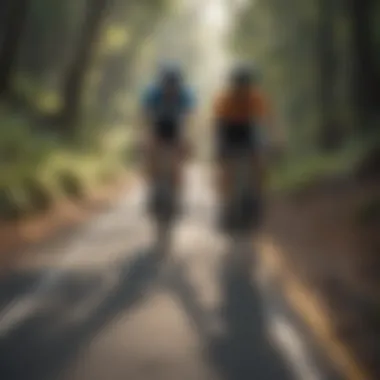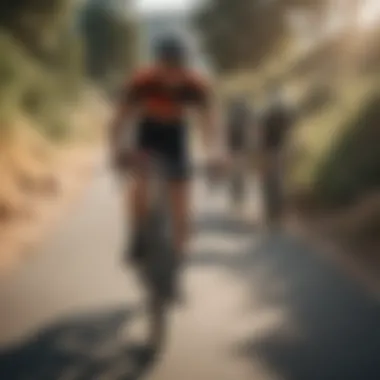Bay Area Biking Events: Your Ultimate Guide


Intro
The Bay Area, known for its stunning landscapes and diverse culture, is a hotspot for cycling enthusiasm. From the bustling streets of San Francisco to the serene trails of Marin County, bike events abound, offering something for everyone. Whether you’re a seasoned racer pushing your limits or a casual rider enjoying a leisurely Sunday voyage, the cycling scene here caters to all.
Cycling in the Bay Area is more than just a mode of transport; it's a lifestyle woven into the fabric of the community. It serves as a perfect conduit for meaningful connection, personal growth, and advocating for sustainability. This guide will lead you through the rich tapestry of bike events across the region, helping you understand their significance for local cyclists as well as the broader cycling culture. With various opportunities to engage, participants can delve into the logistics of each event while navigating the trends shaping the biking community in this vibrant part of the world.
By highlighting key events, examining their relevance, and addressing both the joys and challenges cyclists face, this article seeks to empower you with knowledge and insights, ensuring you make the most of your biking adventures. Let’s commence this exploration, pedaling through the hills and valleys of the Bay Area cycling scene.
Preamble to Bike Events in the Bay Area
The Bay Area has carved out a notable niche in the cycling world, where bike events flourish in various forms. These gatherings not only attract those with a competitive spirit but also nurture community ties among riders of all levels. The importance of bike events cannot be overstated, as they serve as a lively arena for both current cyclists and those considering taking up the sport. It helps in fostering camaraderie, encouraging fitness, and advocating for an eco-friendly mode of transport.
Historical Context of Cycling
Cycling in the Bay Area has a rich history, tracing back to the late 19th century. San Francisco played a pivotal role in the early days of cycling in America. The reputation of the city as a cycling destination grew with the establishment of cycling clubs and advocacy groups. Not only did these organizations push for better infrastructure, but they also organized events that embraced a wide array of riders, from the casual to the hardcore.
In those early days, the bike was a symbol of independence and mobility. The roads may not have been as welcoming then as they are today, but it sparked a passion for various forms of cycling. Over time, the Bay Area witnessed the rise of distinct cycling events that reflect both the culture and the geography of the region, paving the way for what we see now.
Why the Bay Area is a Cycling Hub
The Bay Area stands out as a cycling hub for a few compelling reasons. First off, the Geography plays a crucial role; with its diverse landscapes ranging from urban sprawls to coastal routes and rolling hills, it provides an unmatched setting for every kind of cyclist. Riders flock to experience the gorgeous views of the Golden Gate Bridge or the breathtaking terrains of Marin County.
Moreover, the community in the Bay Area actively champions cycling culture. Local organizations work tirelessly to promote cycling as a mainstream mode of transport. Numerous bike lanes and trails exist, catering to the needs of both recreational cyclists and ambitious racers. There is a palpable enthusiasm for events that cater not just to racing but also social rides, charity events, and theme-based scavenger hunts.
Cycling events here are not just gatherings; they are a homage to the local culture and the lifestyle. They bring together individuals from different backgrounds, fostering a sense of unity and purpose among participants. As we delve deeper into the various events, it becomes evident that bicycle rides are more than just a sport; they reflect values of sustainability and community engagement, giving the Bay Area a unique standing in the cycling landscape.
Types of Bike Events
When one flips through the calendar of events gracing the Bay Area’s cycling scene, it is apparent that the variety is staggering. Understanding the different types of bike events is essential; it not only allows cyclists to find activities that resonate with their skills and interests, but it also fosters a sense of community among bikers. Each category of event, whether competitive or recreational, serves distinct purposes and appeals to different audiences, making biking in this region truly dynamic.
Competitive Racing Events
Road Racing
Road racing is more than just a sport; it can be seen as a rite of passage for many serious cyclists. It typically involves timed events on paved roads, testing not just speed but endurance and strategy. The adrenaline rush of a tightly contested finish line can’t be understated. Moreover, road racing’s popularity stems from its accessibility — with countless criteriums and road races occurring throughout the year, finding a local race to enter is relatively easy. One unique feature of these events is the camaraderie among competitors, as they often share tips and encouragement before, during, and after the race.
However, the disadvantages, like high registration fees and the need for intensive training, can deter casual riders.
Mountain Bike Endurance
Distinct from its road counterpart, mountain bike endurance events embrace challenging terrains and variable weather conditions. A ride through rugged trails can bring out the best, and sometimes the worst, in a cyclist — testing physical and mental fortitude alike. The key characteristic of these events is the likely unpredictability of the course, often featuring steep climbs, rugged descents, and tight turns. Participants often find themselves quite literally in the heart of nature, witnessing breathtaking views while pushing their limits.
One unique feature of mountain bike endurance races is their generally relaxed atmosphere compared to road racing, making them appealing to more adventurous souls seeking a fun challenge. On the flip side, the rugged conditions can raise concerns around safety, requiring appropriate gear and techniques for navigation.
Criterium Events
Criteriums bring a different flavor to competitive cycling with their short, fast-paced races, usually held on closed city blocks. The nature of these events encourages strategic thinking; cyclists must conserve energy while also knowing when to sprint. The vibrant atmosphere of crit races, often held amidst cheering crowds and cultural festivities, makes them a crowd favorite in urban settings.
The charm lies in their accessibility for both the riders and the spectators. Giving onlookers a chance to witness high-octane competition without long commitments to travel is invaluable. However, the compact courses can lead to some tense moments, particularly among less experienced racers who may find themselves in the thick of it unexpectedly.
Community and Recreational Rides
Charity Rides
Charity rides serve a dual purpose: they challenge cyclists and raise awareness for vital causes. Typically marked by a festive atmosphere, these events attract both seasoned cyclists and newcomers interested in participating for the greater good. The main appeal lies in the spirit of togetherness, where participants create a sense of community while supporting various initiatives.
One unique aspect of charity rides is the variety of distances available, catering to different experience levels. While they offer a chance to give back, some drawbacks include the potential for high average speeds, which might not sit well with those aiming for a leisurely ride.
Themed Rides


Who doesn't love a good theme? Themed rides transform the cycling experience into an imaginative undertaking. From costume rides to holiday-themed events, these gatherings encourage participants to break free from tradition and express themselves. The key factor here is creativity; themed rides uplift spirits and promote a fun environment.
The unique feature of themed events lies in their ability to foster connections among cyclists who share similar interests, be it love for a particular film or holiday. Still, whether the quirky costumes distract from the ride itself can be seen as a disadvantage for serious cyclists.
Social Cycling Gatherings
Finally, social cycling gatherings bring relaxation and connection to the fore. They are less about competition and more about enjoying the ride while engaging with fellow cycling enthusiasts. Often organized by local clubs, they present easy-going opportunities to explore new routes while making friends along the way.
The key aspect of these gatherings is their focus on community. It provides an excellent opportunity for newcomers to meet veterans who can offer guidance and share experiences.
Although the laid-back nature makes these gatherings appealing, some riders may miss the adrenaline of competition.
Destination Rides and Tours
Scenic Routes
Scenic routes stand as a hallmark of cycling in the Bay Area, where breathtaking mountain views and coastal vistas captivate riders every mile. These rides are designed to offer a visual feast while giving cyclists a good workout. The main attraction is undoubtedly the stunning scenery at various stopping points that invite a quick breather or even a photo op.
However, while they provide a chance to connect with nature, navigational challenges may arise, particularly on less-marked paths, leaving some cyclists feeling lost at times.
Historic Trails
Ba Area’s rich history unfolds beautifully along its historic trails, where each pedal stroke echoes tales of the past. These biking paths often allow riders to enjoy a leisurely pace while visiting landmarks that tell stories of yesteryears. The main advantage of historic trails lies in their educational aspect, inviting cyclists to learn more about the region while enjoying a pleasant ride.
Nevertheless, the less thrilling terrain when compared to modern trails might leave thrill-seekers craving for something more exhilarating.
Guided Tours
Lastly, guided tours allow cyclists to explore the area without the hassle of planning. Typically led by knowledgeable locals, participants can sit back and soak in the sights while listening to anecdotes that bring the landscape to life. The well-planned nature of these events means that riders can focus on enjoyment rather than logistics.
However, the downside could be the limitation on one's own pace, as the group dynamic can sometimes feel restrictive for those wanting to go at their own speed.
Notable Annual Bike Events
When we think about the Bay Area’s cycling scene, several remarkable annual events take center stage. These gatherings serve as a focal point for cyclists of all experience levels, and their importance stretches beyond mere entertainment. They foster a sense of community, promote cycling as a lifestyle, and support various causes that benefit both participants and the environment. Here’s a deeper look at notable events in this diverse region, revealing their unique characteristics and communal impact.
San Francisco Bike Expo
The San Francisco Bike Expo is not just another date on the calendar; it's a celebration of cycling in its myriad forms. Held typically in early November, this expo brings together cycling enthusiasts from all corners of the nation. The atmosphere is electric, pulsating with the excitement of live demonstrations, inspiring talks by industry leaders, and an impressive array of vendors showcasing both innovative gear and local cycling culture.
Key Highlights:
- Workshops and Panels: Participants can dive into various topics, including bike maintenance, safety, and cycling advocacy. These sessions offer hands-on experience and are perfect for newcomers eager to learn.
- Local Community Involvement: The event often collaborates with local nonprofits that focus on cycling education and environmental sustainability, making it a platform for advocacy as much as a showcase.
- Networking Opportunities: For those looking to connect, the expo is filled with opportunities to meet other cyclists and industry professionals.
Overall, the San Francisco Bike Expo stands as a vital venue for knowledge-sharing and community-building, making it a must-attend for anyone passionate about cycling.
Bay Area Bike Share Events
Bay Area Bike Share events play a significant role in promoting sustainable transportation and accessibility in urban biking. These events come in various forms and are designed to encourage more people to explore cycling, thereby enhancing the vitality of public spaces.
Events to Note:
- Launch Parties: Whenever new bike stations are added, launching events usually clear the way for community engagement. Such gatherings feature local musicians, food trucks, and interactive bike workshops.
- Bike to Work Day: An annual event that encourages employees to cycle to work, often celebrated with breakfast stations at various locations. It increases awareness about cycling as a viable mode of transport.
- Community Rides: Throughout the year, regular rides are organized to familiarize residents with city routes and promote bike culture. These rides aren’t about speed; they are meant for enjoyment and exploration.
The Bay Area Bike Share events underline the importance of cycling in urban settings, as they enable more citizens to participate in bike culture, promoting both health and eco-friendliness.
Tour de Bay Area
Tour de Bay Area is a highlight in the calendar for serious cyclists and leisure riders alike. This event encapsulates the spirit of adventure, taking participants through some of the most breathtaking routes in the Bay Area, often featuring stunning coastal views and challenging terrains.


What Makes it Unique:
- Diverse Course Options: Riders can choose from different distances catering to all levels. Whether it’s a leisurely 20-mile course or an intense 100-mile challenge, there’s something for everyone.
- Scenic Beauty: Participants traverse through cities, parks, and along the coast, making it a visual feast as well as a physical challenge. Stopping points along the way offer refreshments and encouragement from local volunteers.
- Fundraising Aspect: Many Tour de Bay Area events also raise funds for various charities, addressing issues like health awareness and environmental concerns.
This tour does not merely attract adventure seekers; it builds a shared experience, fostering a sense of camaraderie amongst riders who share the joy of cycling.
"Cycling is not just about the destination; it’s about the journey and the people you meet along the way."
In summary, these notable annual bike events in the Bay Area serve not only as personal challenges but also as community gatherings that promote a healthy, sustainable way of life. They showcase how cycling can bond individuals while fostering a culture that prioritizes both fitness and social engagement.
Participation and Preparation
When considering bike events in the Bay Area, the importance of participation and preparation cannot be overstated. Getting involved means more than just signing up; it's about understanding what the event entails, how to gear up, and what to expect on the day itself. Proper preparation vastly enhances not only your experience but also your safety and performance.
Getting ready for a bike event involves several elements that can make or break your day: the gear you carry, the knowledge you possess, and the state of mind you bring. All these factors fuse together to create a fulfilling and enjoyable event.
Essential Gear for Participants
Bike Maintenance Tools
Bike maintenance tools are a cornerstone of being ready for any cycling event. Among these tools, a multi-tool is indispensable. It combines various functions such as fixing a flat tire or making adjustments to gears. The key characteristic of these tools is their versatility. A quality multi-tool allows you to quickly address issues that might otherwise derail your ride.
One unique feature is the ease of portability—many can fit snugly in a pocket or attach to your bike frame. Riders appreciate this convenience as it allows for quick access during events. However, it's crucial to remember that not all multi-tools are created equal; some may lack the tools necessary for a specific repair. Thus, it's wise to research models or even test out tools before the event.
Safety Gear and Helmets
Safety gear, especially helmets, holds the frontline in protecting cyclists from potential accidents. A well-fitted helmet is not just a legal requirement for many events; it's also a lifesaver should things go awry. The crucial elements of safety gear include visibility and impact resistance. Riders often choose bright colors or reflective materials to ensure they’re seen by others.
The unique feature of modern helmets is their advanced design that balances protection with comfort, often incorporating ventilation and adjustable straps. While they can be a bit pricey, the investment in quality safety gear is invaluable for anyone serious about participating in cycling events.
Hydration and Nutrition
Keeping hydrated and nourished is essential for endurance during bike rides. Proper hydration methods include using water bottles or hydration packs, which make it easy to sip while on the go. The vital characteristic of hydration and nutrition is that they directly affect performance. Once riders become dehydrated, their physical ability diminishes significantly.
A unique feature of many hydration systems is their accessibility; some even enable hands-free drinking. But here’s the catch—relying just on water isn’t enough for longer rides. Incorporating sports drinks or gels can provide the necessary electrolytes for endurance events, helping to avoid fatigue or cramping.
What to Expect on Event Day
The magic of an event day lies not just in the ride, but also in the anticipation of what unfolds. Knowing what to expect helps to ease nerves and enhances enjoyment.
Event Schedules
Event schedules outline key timings for participants, from check-in to the start of the ride. Reviewing the schedule can help cyclists plan their morning, including when to arrive and any pre-ride warm-ups. The ideal schedule is user-friendly and structured, allowing participants to catch important moments, such as safety briefings.
What sets well-prepared schedules apart is their detail, often including estimated finish times. This information can be crucial when coordinating with friends or family waiting at checkpoints or finish lines.
Check-in Procedures
Check-in procedures often involve confirming your registration and collecting any essentials like race packets. They are designed to streamline the process and limit congestion. A smooth check-in procedure not only makes the experience pleasant, but it also sets the right tone for the day.
One key aspect is having volunteers or staff on hand to guide participants through the process, which significantly reduces confusion. A drawback might be long lines, so arriving early is often suggested.
Course Maps
Course maps are another critical resource provided ahead of the event, detailing the route cyclists will follow. They illustrate elevation changes, water stations, and any potential hazards. Knowing the course can alleviate uncertainties about where to push harder and when to conserve energy.
The unique feature of many course maps today is their digital availability, often found on event websites or even as mobile applications. While some maps are straightforward, others may include excessive detail, which could overwhelm less experienced riders. It's essential to familiarize yourself with the key points of the route before the day arrives.
Understanding these facets of participation helps ensure that riders are not just showing up to ride, but are prepared to tackle all that the event offers!


Being well-prepped and knowing what to expect on the event day typically leads to a more satisfying experience. Whether you’re a seasoned cyclist or a newbie, these preparations pave the path for a terrific outing.
Environmental and Cultural Impact
Understanding the environmental and cultural impact of cycling events in the Bay Area is crucial for grasping their broader significance. The connection between cycling and environmental sustainability elicits a conversation about how we can navigate urbanization and climate change. These events are more than just mere activities; they are a canvas showcasing a commitment to developing more eco-friendly lifestyles.
Promoting Sustainable Transport
Cycling presents itself as an undeniably sustainable mode of transportation. With concerns about pollution and traffic congestion looming large, biking acts as a breath of fresh air—quite literally. Each pedal stroke contributes to a decline in carbon emissions, which is especially vital in bustling cities like San Francisco and Oakland. Consider this: a single bicycle can save nearly 1,000 pounds of CO2 emissions per year compared to a car. With Bay Area leading the way, bike events aim to spread the message of sustainability.
Additionally, these biking gatherings encourage local governments to invest in cycling infrastructure—think dedicated bike lanes, bike-sharing programs, and secure parking spaces. Improved cycling routes not only weave through cities efficiently but also enhance pedestrian safety. When municipalities see active participation in such events, it can catalyze long-term changes in transport policies.
"The bicycle is a curious vehicle. Its passenger is its engine." — John Howard
Community Engagement and Development
The cultural aspect of cycling events is just as significant as their environmental benefits. These gatherings naturally foster a sense of community. Diverse groups of people converge, representing various backgrounds and walks of life. The collective enthusiasm for cycling creates a social fabric that can bridge gaps in communities.
Moreover, these events serve as a platform for local businesses, artists, and cultural initiatives. For instance, bike expos often showcase local artisans, bike shops, and food vendors, augmenting the local economy. Participants are more inclined to engage with community resources, from learning about sustainability to discovering new local hotspots.
Cycling events also empower grassroots movements advocating for cycling rights and inclusivity. A considerable number of cyclists are advocating for more equitable access to cycling resources among various demographics, pushing for changes in how communities perceive biking as a viable form of transport. In this light, biking becomes not merely a recreational activity but a tool for social change.
In summary, the environmental benefits of cycling are profound, and the cultural implications cannot be understated. Each ride contributes to a collective awareness and responsibility towards our planet, while also nurturing the communities we inhabit. The Bay Area serves as a prime example of how bike events can stir environmental advocacy and community cohesion simultaneously.
Emerging Trends in Cycling Events
As the world shifts and evolves, so do the cycling communities and events that bring enthusiasts together. Emerging trends in cycling events not only signify changes in the way people ride but also reflect broader societal movements. Understanding these trends can help participants adapt to the ever-fluctuating landscape, ensuring that they are not only keeping pace with modernity but also embracing the innovations that are reshaping the cycling experience.
Virtual Events and E-Bike Integration
In the age of digital connections, virtual cycling events have gained momentum, especially during the global pandemic when traditional gatherings either canceled or transformed. These events offer participants the convenience of joining races or rides from the comfort of their homes, utilizing cycling apps such as Zwift or Strava. This tech-infused approach provides a fresh perspective on competition and camaraderie. Riders can connect, compete, and log their miles while remaining physically apart.
E-bikes, with their growing popularity, have further fueled this evolution. These electric bicycles appeal to a broader demographic, from seasoned cyclists looking for relief on long climbs to those new to riding who might find traditional bikes daunting. Integrating e-bikes into virtual events makes them more accessible, allowing diverse participants to hesitate less and join in the fun. The blending of technology and cycling is paving new avenues for engagement, reaching riders who might have once stayed on the sidelines. Through these events, the cycling scene is becoming a digital tapestry, woven with threads of innovation and inclusivity.
"Riding is not just about the distance; it's about the connection you make along the journey. Virtual events have redefined that journey, allowing anyone to ride alongside the world!"
Inclusivity in Cycling Events
As society progresses, so does the understanding that cycling events should cater to all individuals, regardless of background, age, or ability. Inclusivity in cycling events not only acknowledges but also celebrates diverse groups, encouraging participation across various demographics. Events such as the Bay Area's Ride for Refugees or Women’s Cycling Series are shining examples of this trend. They create spaces for underrepresented cyclists to share their passion for biking, united by inclusivity.
A notable consideration in fostering inclusivity is addressing accessibility. Events are increasingly incorporating adaptations like accessible routes and varied pacing options to ensure all riders can participate comfortably and safely. Furthermore, offering education and training programs for novice cyclists can empower those who’ve shied away in the past.
The growth of community-oriented rides reflects this trend. These gathering aren’t just for the elite cyclist and serve as platforms for connection, learning, and exploration of the shared love of cycling. Such efforts lay the groundwork for a cycling culture that welcomes everyone, creating a robust environment where all can thrive and enjoy the freedom that rides bring.
Ultimately, understanding these emerging trends—like the rise of virtual events and the push for inclusivity—reveals the dynamic nature of the Bay Area's cycling scene. Not only do these trends enhance the way we connect with cycling, but they also position the Bay Area as a trailblazer for future cycling cultures.
Finale
As we wrap up this journey through the vibrant bike events of the Bay Area, it becomes clear that these gatherings are much more than just an opportunity to ride. They symbolize a culture that embraces community, competition, and sustainability. The conclusion serves to emphasize the growing importance of these events, both for individual participants and the larger ecosystem surrounding cycling.
The Future of Cycling in the Bay Area
Looking ahead, the cycling landscape in the Bay Area appears not just promising but transformative. With more cyclists hitting the roads every day, we can expect to see an increase in cycling infrastructure, such as dedicated bike lanes and maintenance stations.
Moreover, innovations like electric bikes are gaining traction, making cycling more accessible to a wider audience. E-bikes level the playing field, allowing individuals of various fitness levels to participate in biking events. This shift is hugely beneficial, as it encourages participation regardless of age or experience.
Riding events will continue to adapt and become inclusive. Efforts are being made to ensure that everyone, regardless of ability, can join in on the fun. More events are starting to incorporate adaptive biking options, which shows a real commitment to inclusivity.
The integration of digital tools isn't small potatoes either. Virtual events have become a norm, providing a convenient platform for those who may not attend in person due to various limitations. They allow participants to connect with communities beyond geographical boundaries.
In short, the future isn’t just about more bikes on the road; it's about creating a robust, engaging culture around cycling. The Bay Area stands at the forefront of these developments, setting an example not only locally but globally.
As we ponder the future, it’s essential for participants, organizers, and advocates to engage in lasting conversations about safety, accessibility, and the environmental benefits of cycling.
Moving forward, we are not only witnesses to a cycling renaissance but also active participants in shaping this vibrant community. The path ahead is paved with possibilities, and it’s up to us to ride it.







